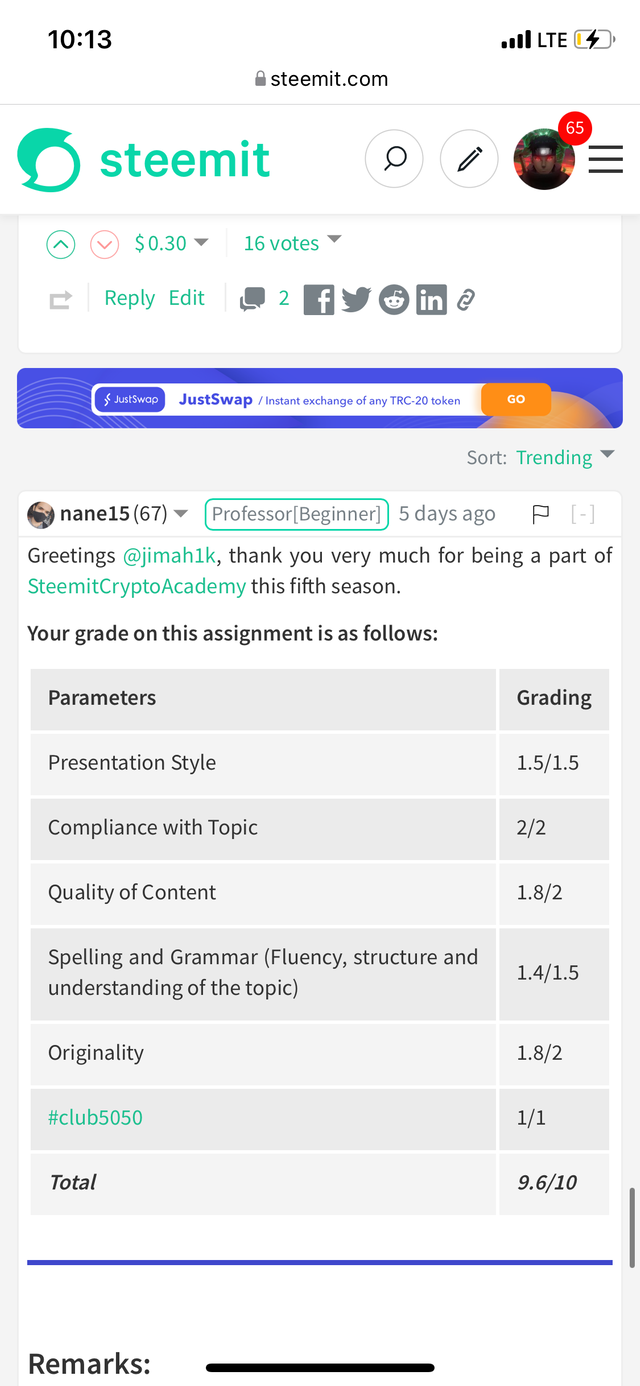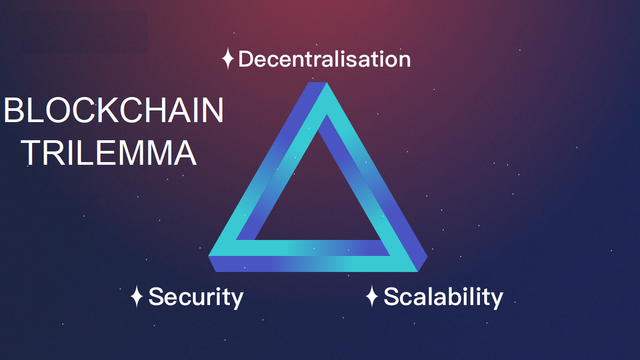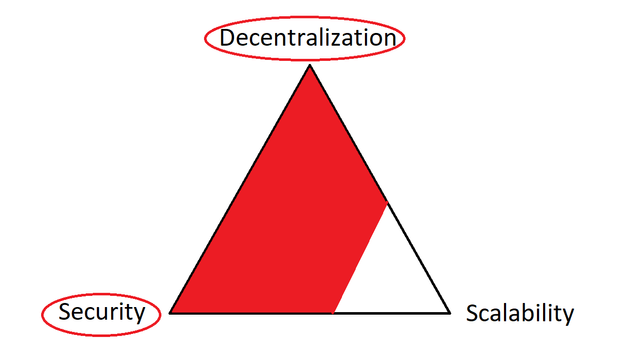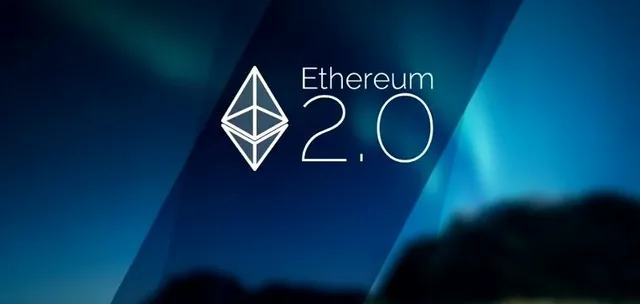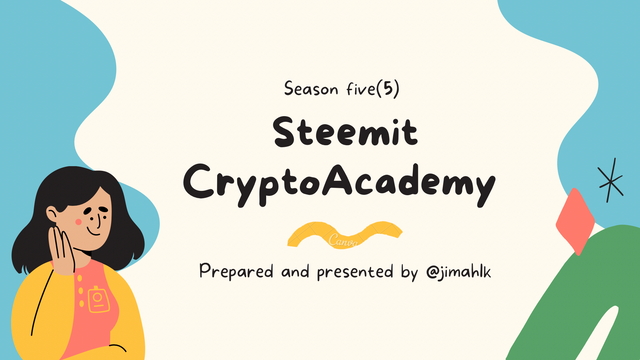
It’s another week of this seasons CryptoAcademy, the journey has been long and am sure that every single student and professors here have learnt one or two things that will help shape our lives.
It’s my pleasure to meet you here again and m very happy to be lectured by you. After reading the lecture notes and doing some research, I will present my solutions to the questions asked.

Q1 : Explain in your own words what the Blockchain Trilemma is.

Actually the first time I heard of the word Trilemma was from the the lecture notes you provided even without reading further I had an idea that since it’s trilemma we will be dealing with three options or choices. I was very exited because Whatever I will be learning would be something new.
Some of characteristics of the blockchain are Decentralization, security and scalability. Vitalik Buterin Who is the founder of the Ethereum network came out with the concept that having developed the Ethereum blockchain it is highly difficult for programmers and developers to create a blockchain network that will posses all the three characteristics at the same time. The developers would have to choose to ignore one.
What this means is that based on his concept the blockchain can either be decentralized and secured, or secured and scalable or decentralized and scalable but not all the three characteristics at a go.
Let me explain the three characteristics am talking about so that you will understand it more.
1 - Decentralization - when we talk about decentralization it simply means the platform or blockchain is not controlled by a single person or is not under control of a central authority rather decision concerning the platform are done by the users.
2 - Scalability - This is simply the amount of transactions a blockchain can carry within a short period of time or in other words how fast the transaction will be carried out. Scalability if the blockchain differs from one blockchain to the other.
3 - Security - I think this is the most import property most people look out for when choosing a blockchain. It’s simple what layers are put in place to stop attacks like the race attack and stoping people from stealing other users assets.
Now that I have explained the concept of trilemma let’s take a look at an example of a blockchain and the features or properties they have chosen to neglect. Let’s start with Bitcoin(BTC)
1 - Bitcoin
Bitcoin we all know is a decentralized platform I know that you will all know what decentralization is because I have explained it above. When we talk about the security of Bitcoin, it uses cryptography to secure it assets. Cryptography is simply using the public key to encrypt and using the private key to decrypt data. It will take about 100 years for a super computers to crack a hash function. This should tell you how secured it is
That’s two out of three, let’s check for scalability. This is where Btc falls short because it is not scalable BTC uses 10mins to verify a block and 7 transactions are performed every second. Below is the Bitcoin scalability trilemma
Over the years some blockchain have felt the need for the network to have all these properties hence have tried to develop some ways for the blockchain to be scalable, secured and decentralized one of the blockchain that have solved the trilemma issue is cardano and solana.
Solana network have found a way of using proof of stake and proof of history which greatly increases its scalability speed by so doing solana is able to perform 50,000 transactions per second.

Q2 : Is the Blockchain Trilemma Really a Trilemma?

Well, if you have truly researched on the blockchain trilemma your answer would be NO!!. Why would I say this?? This is because for a blockchain to become a trilemma, it should be hard or let’s say impossible for that particular blockchain to have the three characteristics or properties together(Scalability, Security and decentralization)
Day in day out the blockchain is advancing and we are seeing that some blockchain have started or have developed like the cardano network have developed or found out ways for their network to be scalable, secured and decentralized in nature.
So The general term Blockchain trilemma can’t be used anymore since some blockchain have working solutions to the problem and I believe that in a few years to come all the blockchains will solve this problem.
Let me explain to you how Cardano have solved the trilemma. Not long ago cardano’s team came out publicly to announce the lunch of smart contracts. However the only thing standing in the way of this goal was to increase the scalability of the network. Cardano network has fused Ouroboros consensus protocol and the proof of stake consensus protocol running them simultaneously. According to the cardano team ourborous will increase the scalability of the network and also help strengthen the network.
How does cardano strengthen its security?? Generation of new blocks are randomly selected. Nodes called the interval nodes are responsible for creating the blocks, the randomizing mechanisms has the ability to detect spamming or
Malicious intent when this is detected, the node is disconnected and the other nodes will continue to function. This is how the network is secured.

Q3 : Define the following concepts in your own words:

1 - Decentralization
I think this is a major building block in the blockchain. I say this because decentralization is the process where by a platform or an organization is not controlled by a single authority or it’s a platform or organization which is not managed or run by a one person because power is given to the people in terms of decision making and more.
Decentralization in the blockchain aims to remove all third parties that are available in the centralized system. They users are directly connected to the buyer (P2P). Removing of the third parties in transactions has its good sides because we will no longer pay additional transactions fees which will be allocated to the middle men.
Decentralization in the blockchain ensures transparency, transactions carried out on the platform can be viewed using the blockchain explorer which will include details like the sender and receivers name, the time it was sent and many more.
In decentralized platforms, power is given to the users when it’s comes to decision making the users who hold tokens will vote on matters concerning the governance or any other relevant concerns.
2 - scalability
When we talk about scalability, it simply refers to the ability of a blockchain network to perform high number of transactions within a limited time. Certain blockchain can carry out thousands of transactions within a second whiles other blockchain needs more time in other to carry out thousand transactions. So the blockchain which Carries out thousand transactions within a Second is considered more scalable than the one that need more time to carry out the transactions.
Scalability of the blockchain differs from blockchain to blockchain this is as because of the number of nodes present in the network.
The consensus mechanism is also a factor that can influence the scalability of the blockchain. Let’s take a look at the scalability of btc, in every second it performs 7 transactions according to my research btc is the slowest cryptocurrency. The fastest according to my research is EOS, can perform millions of transactions in one Second.
Ethereum is a little bit faster than Bitcoin it executes 13 transactions per second. You can see that scalability is an issue for both BTC and ETH
3 - Security
I think security is greatly cherished everywhere. Security in the blockchain refers to how the blockchain is resistant to malicious attempt and Hacks. Depending on the blockchain, or let me say some blockchain have different ways of protecting their network from hacks and attacks. Let’s take a look at Bitcoin for instance, this network uses cryptography as a way of securing its network.
Cryptography is a very powerful security tool which makes good use of the public and private key to encrypt and decrypt data. It is stated that it will take super computers a century to crack a hash function of an encrypted data. Who has that luxury of time??
When you look at cardano network, the randomizing mechanism has the ability to detect malicious attempts and when it does, it takes action by disconnecting that node whiles the others continue to create blocks (but are randomly selected).

Q4 : Based on your knowledge, explain at least two viable solutions to the challenges posed in the Blockchain Trilemma.

After understanding the concept of the blockchain trilemma, I think it’s very ideal we try to solve these problems I will be presenting some solutions I think will be of help.
1 - Sharding
When we say sharding, it simply means dividing or allocating or partitioning parts of the technology, these parts are termed as shards. Each part or share is going to be unique from the other shards because they won’t contain the same information.
When this is done, the main problem of scalability will be improved and the blockchain will have an increase with the number of transactions they are able to carry out in a Second.
How are shards partitioned?? Shards can be divided into rows. Each row will be will have a unique a different function from the other row let’s say the first row will be responsible for recording transaction details.
2 - Changing POW to POS
I think the main reason why the Bitcoin blockchain is very slow is the consensus algorithm it uses which is the proof of work algorithm. This requires high power computers to solve complex mathematical problems in other to validate and verify a block.
Let’s not forget that proof of stake is meant to solve the scalability issues of the proof of work, in this consensus algorithm the validation of blocks is determined by the number of coins you hold not using any super computers to solve complex mathematical problems and as a result is very scalable as compared to the proof of work. It also cuts the high energy the proof of work consumes.
We can see that Ethereum is making great effort to change the proof of work algorithm by upgrading to Ethereum 2.0 which will use the proof of stake consensus algorithm
3 - Sidechains
This comes from the word side blockchain bit it’s usually abbreviated to sidechain. To make this term very simple to understand, I would say a side chain is a blockchain that is connected to another blockchain using a two-way peg.
A user can decided to transfer his assets from the main chain to the side chain for safe keeping when you feel the need to use the assets you can equally transfer the assets back.
One major way the side chains can solve scalability issues of the blockchain is, transactions can be carried out on either the side chain or the main chain this would greatly increase the scalability of a blockchain
Think of a side chain as another chamber that can store information and also carry out transactions. By so doing the main chain would not be chocked with a whole lot of transactions hence the transactions would be carried out faster.

Conclusion

The degree at which technology is advancing these days is very fast and I believe that in a few years to come most of the blockchain would have implemented solutions on how to go around the blockchain trilemma. Because having a blockchain which will good at only two aspects is not the best as they are all very important and we can’t ignore the other.
With the likes of Cardano and ETH and co trying to solve this problems should trigger the other blockchain to follow their footsteps. I made mention that EOS has a very fast scalability rate, i believe because it runs in the proof is stake consensus algorithm is what makes it very scalable. Thank you professor for this wonderful lecture I hope to see you next week
@nane15 here is the LINKto the original post
